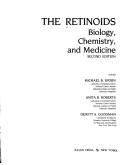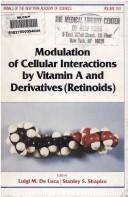| Listing 1 - 7 of 7 |
Sort by
|

ISBN: 0781700825 Year: 1994 Publisher: New York Raven Press
Abstract | Keywords | Export | Availability | Bookmark
 Loading...
Loading...Choose an application
- Reference Manager
- EndNote
- RefWorks (Direct export to RefWorks)
Retinoids --- Rétinoïdes --- Retinoids. --- 615.27 --- Agents affecting metabolism and cell functions --- 615.27 Agents affecting metabolism and cell functions --- Rétinoïdes --- Vitamin A analogs --- Vitamin A congeners --- Vitamin A derivatives --- Carotenoids --- Diterpenes --- Interphotoreceptor retinoid-binding protein

ISBN: 0897661079 0897661087 9780897661072 Year: 1981 Volume: 359 Publisher: New York (N.Y.) New York academy of sciences
Abstract | Keywords | Export | Availability | Bookmark
 Loading...
Loading...Choose an application
- Reference Manager
- EndNote
- RefWorks (Direct export to RefWorks)
Animal biochemistry --- Zoohistology. Zoocytology --- Vitamin A --- Retinoids --- Cell interaction --- Metabolism --- Congresses --- Physiological effect --- 577.161.1 --- Vitamin A group --- 577.161.1 Vitamin A group --- Retinol --- Carotenes --- Vitamins, Fat-soluble --- Beta carotene --- Retinal (Visual pigment) --- Vitamin A analogs --- Vitamin A congeners --- Vitamin A derivatives --- Carotenoids --- Diterpenes --- Interphotoreceptor retinoid-binding protein --- Metabolism&delete& --- Physiological effect&delete& --- Vitamin A - Metabolism - Congresses --- Vitamin A - Physiological effect - Congresses --- Retinoids - Congresses --- Cell interaction - Congresses --- Vitamin A physiological effects --- Retinoid-binding proteins --- Retinoids metabolism

ISBN: 3540658920 3642636144 3642584837 Year: 1999 Volume: 139 Publisher: Berlin ; Heidelberg ; New York Springer Verlag
Abstract | Keywords | Export | Availability | Bookmark
 Loading...
Loading...Choose an application
- Reference Manager
- EndNote
- RefWorks (Direct export to RefWorks)
In the future' the decade of the 1990s will likely be viewed as a Golden Age for retinoid research. There have been unprecedented research gains in the understanding of retinoid actions and physiology; since the retinoid nuclear receptors were first identified and the importance of retinoic acid in develop mental processes was first broadly recognized in the late 1980s. Between then and now, our knowledge of retinoid action has evolved from one of a near complete lack of understanding of how retinoids act within cells to one of sophisticated understanding of the molecular processes through which retinoids modulate transcription. In this volume, we have tried to provide a comprehensive update of the present understanding of retinoid actions, with an emphasis on re cent advances. The initial chapters of the volume, or Section A, focus on the physicochemical properties and metabolism of naturally occurring retinoids: - N OY provides an uncommonly encountered view of retinoid effects from the perspective of the physiochemical properties of retinoids. - V AKIANI and BUCK lend a perspective on the biological occurrence and actions of retro- and anhydro-retinoids. Section B considers both the retinoid nuclear receptors and their mechanisms of action as well as synthetic retinoids that have been used exper imentally to provide mechanistic insights into receptor actions and have potential therapeutic use for treating disease: - PIEDRAFITA and PFAHL provide a comprehensive review of retinoid nuclear receptor biochemistry and molecular biology.
Retinoids --- Physiological effect. --- Therapeutic use. --- Therapeutic use --- Physiological effect --- Pharmacology. --- Biochemistry. --- Molecular biology. --- Cancer research. --- Dermatology. --- Pharmacology/Toxicology. --- Biochemistry, general. --- Molecular Medicine. --- Cancer Research. --- Medicine --- Skin --- Cancer research --- Molecular biochemistry --- Molecular biophysics --- Biochemistry --- Biophysics --- Biomolecules --- Systems biology --- Biological chemistry --- Chemical composition of organisms --- Organisms --- Physiological chemistry --- Biology --- Chemistry --- Medical sciences --- Drug effects --- Medical pharmacology --- Chemicals --- Chemotherapy --- Drugs --- Pharmacy --- Diseases --- Composition --- Vitamin A analogs --- Vitamin A congeners --- Vitamin A derivatives --- Carotenoids --- Diterpenes --- Interphotoreceptor retinoid-binding protein

ISBN: 0896034380 9786610836888 1280836881 1592595731 9780896034389 Year: 1998 Volume: 89 Publisher: Totowa, NJ : Humana Press : Imprint: Humana,
Abstract | Keywords | Export | Availability | Bookmark
 Loading...
Loading...Choose an application
- Reference Manager
- EndNote
- RefWorks (Direct export to RefWorks)
Christopher Redfern brings together in Retinoid Protocols a comprehensive collection of key biochemical and molecular methods for retinoid research. These easily reproducible techniques range from methods of handling and analyzing retinoids to advanced protocols for gene targeting, from binding protein function in transgenic animals to the study of nuclear retinoid receptors. In addition, the book makes accessible to all retinoid researchers such advanced techniques as cloning via RT-PCR, fluorimetry methods, recombinant protein purification and characterization, the use of antisense oligonucleotides to study the role of CRABPs, immunological and in situ hybridization methods, photoaffinity labeling, gel-shift analysis, and differential display. Many of the chapters in Retinoid Protocols represent landmarks in retinoid methodology because they give step-by-step instructions for techniques central to understanding cellular control by retinoids. These indispensable techniques will be fundamental for all those working with retinoids, and so will play a key role in the development of new drugs and therapies for treating human disease.
Retinoids --- Laboratory manuals --- Analysis --- Genetic Techniques --- Receptors, Retinoic Acid --- Investigative Techniques --- Carotenoids --- Receptors, Cytoplasmic and Nuclear --- Transcription Factors --- Proteins --- Polyenes --- Pigments, Biological --- Terpenes --- Analytical, Diagnostic and Therapeutic Techniques and Equipment --- DNA-Binding Proteins --- Cyclohexenes --- Biological Factors --- Amino Acids, Peptides, and Proteins --- Alkenes --- Cyclohexanes --- Hydrocarbons --- Organic Chemicals --- Hydrocarbons, Acyclic --- Cycloparaffins --- Chemicals and Drugs --- Hydrocarbons, Alicyclic --- Hydrocarbons, Cyclic --- Laboratory manuals. --- Vitamin A analogs --- Vitamin A congeners --- Vitamin A derivatives --- Diterpenes --- Interphotoreceptor retinoid-binding protein --- Cytology. --- Cell Biology. --- Cell biology --- Cellular biology --- Biology --- Cells --- Cytologists --- Retinoids - Laboratory manuals --- Retinoids - Analysis - Laboratory manuals
Book
ISBN: 0852007434 9401163510 9401163499 Year: 1984 Publisher: Lancaster MTP Press
Abstract | Keywords | Export | Availability | Bookmark
 Loading...
Loading...Choose an application
- Reference Manager
- EndNote
- RefWorks (Direct export to RefWorks)
Dermatologic agents --- Etretinate --- Isotretinoin --- Retinoids --- Skin --- Skin diseases --- Vitamin A --- SKIN DISEASES, drug therapy --- VITAMIN A, analogs and derivates --- VITAMIN A, therapeutic use --- Congresses. --- Testing --- Therapeutic use --- Diseases --- Chemotherapy --- Drug therapy --- Analogs & derivatives --- Skin diseases, drug therapy --- Vitamin a, analogs and derivates --- Vitamin a, therapeutic use --- Vitamin a --- Cutis --- Integument (Skin) --- Beauty, Personal --- Body covering (Anatomy) --- Vitamin A analogs --- Vitamin A congeners --- Vitamin A derivatives --- Carotenoids --- Diterpenes --- Interphotoreceptor retinoid-binding protein --- Accutane (Trademark) --- Cis-retinoic acid --- Retinoic acid, Cis --- -Tretinoin --- Tretinoin --- Drugs, Dermatologic --- Dermatopharmacology --- Congresses --- Testing&delete& --- Therapeutic use&delete& --- Diseases&delete& --- Chemotherapy&delete&
Book
ISBN: 9402409432 9402409459 Year: 2016 Publisher: Dordrecht : Springer Netherlands : Imprint: Springer,
Abstract | Keywords | Export | Availability | Bookmark
 Loading...
Loading...Choose an application
- Reference Manager
- EndNote
- RefWorks (Direct export to RefWorks)
The role of vitamin A in living organisms has been known throughout human history. In the last 100 years, the biochemical nature of vitamin A and its active derivative, retinoic acid, its physiological impact on growth processes, and the essential details of its mechanism of action have been revealed by investigations carried out by researchers using vertebrate and more recently invertebrate models to study a multiplicity of processes and conditions, encompassing embryogenesis, postnatal development to old age. A wealth of intercellular interactions, intracellular signaling systems, and molecular mechanisms have been described and the overall conclusion is that retinoic acid is essential for life. This book series, with chapters authored by experts in every aspect of this complex field, unifies the knowledge base and mechanisms currently known in detailed, engaging, well-illustrated, focused chapters that synthesize information for each specific area. In view of the recent information explosion in this field, it is timely to publish a contemporary, comprehensive, book series recapitulating the most exciting developments in the field and covering fundamental research in molecular mechanisms of vitamin A action, its role in physiology, development, and continued well-being, and the potential of vitamin A derivatives and synthetic mimetics to serve as therapeutic treatments for cancers and other debilitating human diseases. Volume II is divided into nine chapters contributed by prominent experts in their respective fields. Each chapter starts with the history of the area of research. Then, the key findings that contributed to development of the field are described, followed by a detailed look at key findings and progress that are being made in current, ongoing research. Each chapter is concluded with a discussion of the relevance of the research and a perspective on missing pieces and lingering gaps that the author recommends will be important in defining future directions in vitamin A research.
Medicine. --- Gene expression. --- Nutrition. --- Biochemistry. --- Plant biochemistry. --- Proteins. --- Systems biology. --- Biomedicine. --- Gene Expression. --- Animal Biochemistry. --- Protein Science. --- Plant Biochemistry. --- Systems Biology. --- Retinoids. --- Biological chemistry --- Chemical composition of organisms --- Organisms --- Physiological chemistry --- Vitamin A analogs --- Vitamin A congeners --- Vitamin A derivatives --- Composition --- Biology --- Chemistry --- Medical sciences --- Carotenoids --- Diterpenes --- Interphotoreceptor retinoid-binding protein --- Biological models. --- Models, Biological --- Alimentation --- Food --- Nutrition --- Health --- Physiology --- Diet --- Dietetics --- Digestion --- Food habits --- Malnutrition --- Genes --- Genetic regulation --- Health aspects --- Expression --- Proteins . --- Nutrition . --- Computational biology --- Bioinformatics --- Biological systems --- Molecular biology --- Phytochemistry --- Plant biochemistry --- Plant chemistry --- Biochemistry --- Botany --- Phytochemicals --- Plant biochemical genetics --- Proteids --- Biomolecules --- Polypeptides --- Proteomics
Book
ISBN: 3030422828 3030422801 Year: 2020 Publisher: Cham : Springer International Publishing : Imprint: Springer,
Abstract | Keywords | Export | Availability | Bookmark
 Loading...
Loading...Choose an application
- Reference Manager
- EndNote
- RefWorks (Direct export to RefWorks)
This book covers subjects that have major impacts on society, such as the mechanism of maternal-fetal transfer of vitamin A, and the effects of alcohol on retinoic acid signaling and mammalian embryonic development. There has been an awareness of the importance of consuming vitamins throughout human history, but empirical studies of their physiological role and mode of action only began about 150 years ago. Since then, the biochemical nature of vitamin A and its active derivative, retinoic acid, have been identified and researchers around the globe have investigated retinoic acid’s physiological function in growth processes and in maintaining life Written by leading experts, this book discusses the latest findings and advances in retinoic acid research. It addresses topics such as the role of retinoic acid signaling in a multitude of processes, including limb, heart and respiratory system development, as well as its role in maintaining postnatal organ systems. This book is a valuable resource for scientists involved in vitamin A/retinoic acid research and readers interested in developmental biology.
Human physiology. --- Nutrition . --- Embryology. --- Physiology. --- Human Physiology. --- Nutrition. --- Animal physiology --- Animals --- Biology --- Anatomy --- Animal embryology --- Development, Embryological --- Development, Embryonic --- Development, Zygotic --- Embryogenesis --- Embryogeny --- Embryological development --- Embryonic development --- Zoology --- Zygote development --- Zygotes --- Zygotic development --- Zygotic embryogenesis --- Developmental biology --- Morphology (Animals) --- Embryos --- Reproduction --- Alimentation --- Food --- Nutrition --- Health --- Physiology --- Diet --- Dietetics --- Digestion --- Food habits --- Malnutrition --- Human biology --- Medical sciences --- Human body --- Embryology --- Development --- Health aspects --- Cellular signal transduction. --- Retinoids. --- Vitamin A analogs --- Vitamin A congeners --- Vitamin A derivatives --- Carotenoids --- Diterpenes --- Interphotoreceptor retinoid-binding protein --- Cellular information transduction --- Information transduction, Cellular --- Signal transduction, Cellular --- Bioenergetics --- Cellular control mechanisms --- Information theory in biology --- Retinoides --- Vitamina A --- Embriologia --- Fisiologia humana --- Biologia humana --- Ciències de la salut --- Fisiologia --- Mecànica humana --- Reproducció humana --- Cos humà --- Desenvolupament embriològic --- Desenvolupament embrional --- Embriogènesi --- Embriogènia --- Embriologia animal --- Biologia --- Evolució --- Morfologia animal --- Edat gestacional --- Epigènesi --- Cèl·lules germinals --- Cordó umbilical --- Diferenciació sexual --- Fetus --- Gametogènesi --- Genètica del desenvolupament --- Miogènesi --- Neurobiologia del desenvolupament --- Òvuls --- Placenta --- Teratologia --- Biologia del desenvolupament --- Cèl·lules --- Protoplasma --- Reproducció --- Retinol --- Vitamina antixeroftàlmica --- Vitamines liposolubles --- Carotenoides
| Listing 1 - 7 of 7 |
Sort by
|

 Search
Search Feedback
Feedback About UniCat
About UniCat  Help
Help News
News